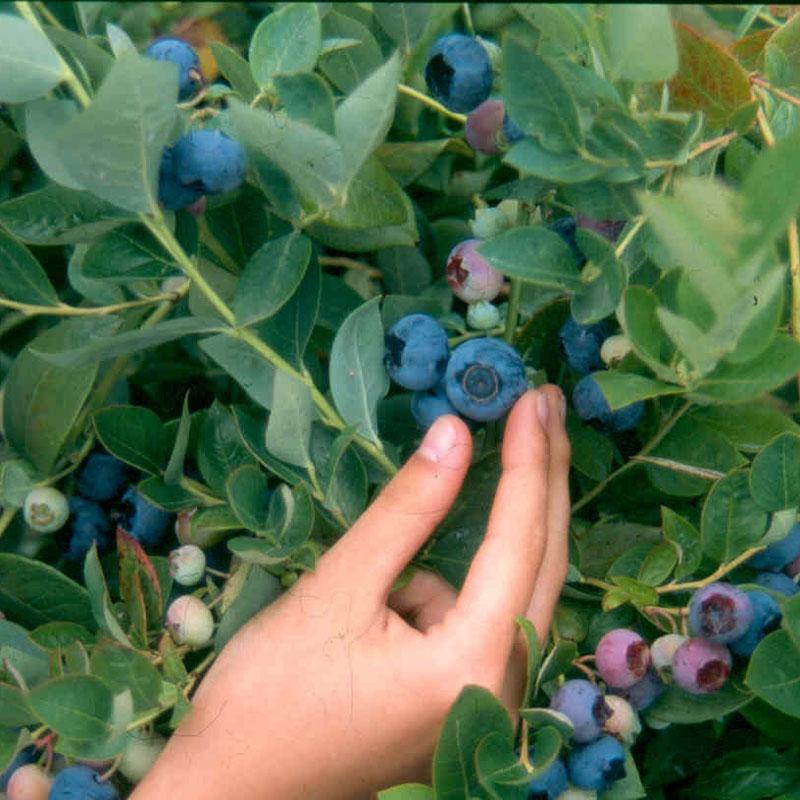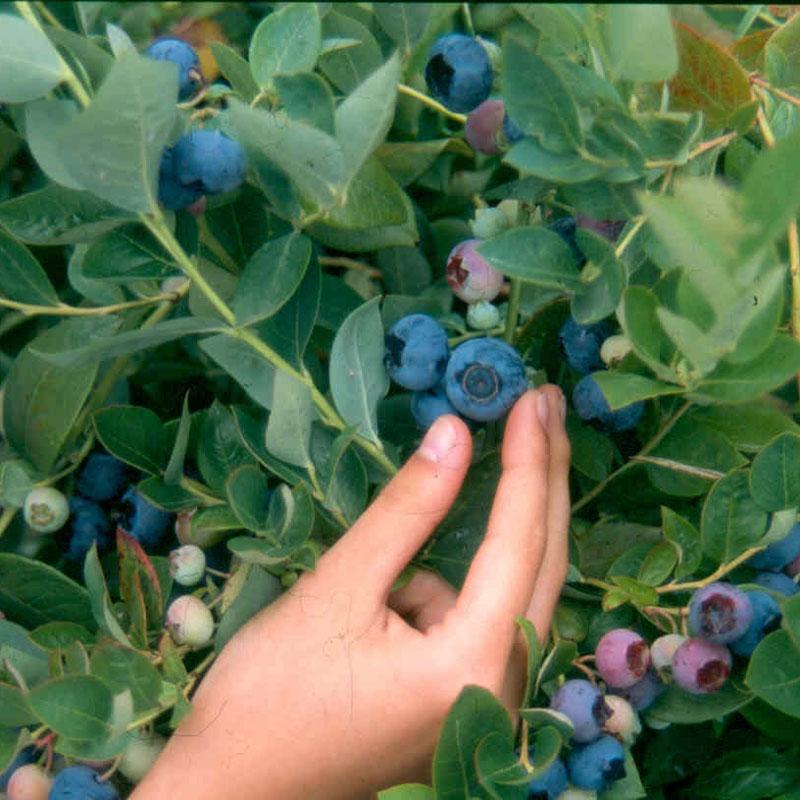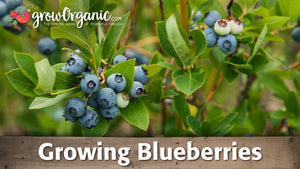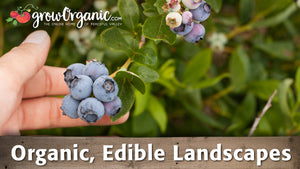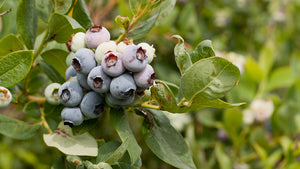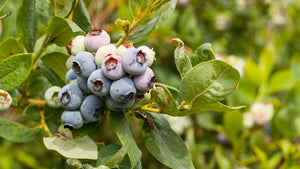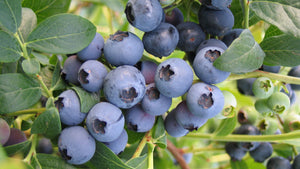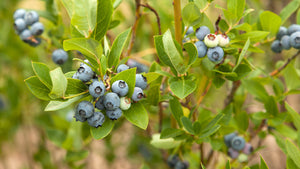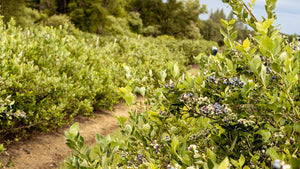Item Number: FV368
Blueberry - Emerald (Mid Harvest)
Blueberry - Emerald (Mid Harvest)
Variety: Southern Highbush
Plant Age: 1.5 years
Zones: 8-10
Chill Hours: 250
Harvest: Mid-season
Bush Habit: Rounded, spreading bush reaching 5'-6' tall with green foliage in fall.
Fruit: Very large, mildly sweet flavored berries.
Facts of note: Emerald yields abundant crops of the largest Southern Highbush berries with a mild, sweet flavor. Its rounded, spreading bush habit make it a great landscape plant.
Dependable in southern climates with a low chill requirement of 250 hours. Long harvest period. Difficult to grow from blueberry seeds.
Emerald Blueberries, scientifically known as Vaccinium corymbosum 'Emerald', are a distinctive variety of the northern highbush blueberries. These plants have gained popularity for their unique characteristics, including their flavor profile, growth habits, and historical development. Understanding the details of Emerald Blueberries helps gardeners and consumers appreciate this particular fruit.
Emerald blueberry plants are popular in the US and thrive in various soils, particularly sandy ones with good drainage. Blueberry plants can grow in many places because they can handle different levels of pH in the soil.
Plant roots absorb nutrients from soil, helping them grow strong all season. Emerald blueberry plants grow lots of tasty berries, making growers happy with their plentiful harvests of sweet fruit.
Blueberries, known for their delicious taste and numerous health benefits, require specific conditions for optimal fruit production. These bushes do well in acidic soil with organic matter like pine bark to keep the pH level stable.
Adequate water and nutrients are essential for blueberry plants, with irrigation systems ensuring consistent moisture levels. Farmers commonly use fertilizers like ammonium sulfate to supply nitrogen, which promotes healthy growth and fruit development. Cross-pollination, facilitated by planting different blueberry varieties nearby, enhances fruit yield. Blueberry roots grow deep into the soil, anchoring the plant and absorbing nutrients for healthy growth and lots of fruit.
Appearance and Flavor Profile
Emerald Blueberries stand out with their large, plump berries that exhibit a deep, glossy blue hue when ripe. These fruits look nice and have a firm texture, so they are great for eating fresh or using in cooking. Blueberry fans love the sweet and slightly tart taste of these berries, finding them refreshing and well balanced.
Growth Conditions and Root Systems
Blueberries are a staple crop in the United States, cherished for their flavorful berries and nutritional value. These plants boast shallow root systems that extend widely, making them well-suited for sandy soils common in many regions.
These blueberries thrive in acidic conditions, with a pH level ideally ranging between 4.5 and 5.5. When planting, ensure the soil is prepared to the appropriate depth, typically around 18-24 inches deep, to accommodate the shallow root system of the blueberry plants. Incorporating organic matter like wood chips into the soil can help maintain acidity levels and improve soil structure.
Blueberries are often cultivated in garden plantings, where they can benefit from mulching with wood chips to retain moisture and suppress weeds. With proper care and attention to soil acidity, depth, and mulching, blueberries can flourish and provide abundant harvests for years to come.
During the growing season, blueberries benefit from consistent moisture levels and adequate sunlight to support robust plant growth and fruit development. Blueberries are versatile plants that can grow in different types of soil and thrive in acidic environments. They are popular in both home gardens and commercial farms.
A cultivar of the northern highbush blueberries, Emerald Blueberries thrive in specific growing conditions. These plants prefer well-drained, acidic soil with a pH range of 4.5 to 5.5. The root systems of blueberry plants, including the Emerald variety, are fibrous and shallow, spreading horizontally rather than deeply. This characteristic necessitates careful soil preparation and regular mulching to maintain soil moisture and temperature.
Emerald Blueberry plants are known for their vigor and productivity. They require full sun exposure for optimal growth and berry production. Additionally, these plants are cold-hardy, making them suitable for cultivation in regions with cooler climates. However, they do require some winter chill hours to produce fruit effectively.
History of the Plant
The history of Vaccinium corymbosum 'Emerald' is intertwined with the broader history of blueberry cultivation. Northern highbush blueberries, the category to which Emerald belongs, are native to North America. The domestication and breeding of these wild plants began in the early 20th century, with the goal of improving berry size, taste, and plant hardiness.
Emerald Blueberries were developed through selective breeding programs aimed at creating varieties with specific desirable traits. These programs focused on enhancing qualities such as berry size, flavor, and the adaptability of the plants to different environmental conditions. The emergence of the Emerald variety is a testament to the success of these breeding efforts.
For more information, please enjoy our Growing Guide for planting and growing blueberries.


Check Your Zone Compatibility:
Compatible with your zone.
Growing Zone for
,

Our Guarantee To You
Since 1976, we've served our customers at every stage of growing. Please contact us at any time. We are happy to support and assist you.
Description
Description
Variety: Southern Highbush
Plant Age: 1.5 years
Zones: 8-10
Chill Hours: 250
Harvest: Mid-season
Bush Habit: Rounded, spreading bush reaching 5'-6' tall with green foliage in fall.
Fruit: Very large, mildly sweet flavored berries.
Facts of note: Emerald yields abundant crops of the largest Southern Highbush berries with a mild, sweet flavor. Its rounded, spreading bush habit make it a great landscape plant.
Dependable in southern climates with a low chill requirement of 250 hours. Long harvest period. Difficult to grow from blueberry seeds.
Emerald Blueberries, scientifically known as Vaccinium corymbosum 'Emerald', are a distinctive variety of the northern highbush blueberries. These plants have gained popularity for their unique characteristics, including their flavor profile, growth habits, and historical development. Understanding the details of Emerald Blueberries helps gardeners and consumers appreciate this particular fruit.
Emerald blueberry plants are popular in the US and thrive in various soils, particularly sandy ones with good drainage. Blueberry plants can grow in many places because they can handle different levels of pH in the soil.
Plant roots absorb nutrients from soil, helping them grow strong all season. Emerald blueberry plants grow lots of tasty berries, making growers happy with their plentiful harvests of sweet fruit.
Blueberries, known for their delicious taste and numerous health benefits, require specific conditions for optimal fruit production. These bushes do well in acidic soil with organic matter like pine bark to keep the pH level stable.
Adequate water and nutrients are essential for blueberry plants, with irrigation systems ensuring consistent moisture levels. Farmers commonly use fertilizers like ammonium sulfate to supply nitrogen, which promotes healthy growth and fruit development. Cross-pollination, facilitated by planting different blueberry varieties nearby, enhances fruit yield. Blueberry roots grow deep into the soil, anchoring the plant and absorbing nutrients for healthy growth and lots of fruit.
Appearance and Flavor Profile
Emerald Blueberries stand out with their large, plump berries that exhibit a deep, glossy blue hue when ripe. These fruits look nice and have a firm texture, so they are great for eating fresh or using in cooking. Blueberry fans love the sweet and slightly tart taste of these berries, finding them refreshing and well balanced.
Growth Conditions and Root Systems
Blueberries are a staple crop in the United States, cherished for their flavorful berries and nutritional value. These plants boast shallow root systems that extend widely, making them well-suited for sandy soils common in many regions.
These blueberries thrive in acidic conditions, with a pH level ideally ranging between 4.5 and 5.5. When planting, ensure the soil is prepared to the appropriate depth, typically around 18-24 inches deep, to accommodate the shallow root system of the blueberry plants. Incorporating organic matter like wood chips into the soil can help maintain acidity levels and improve soil structure.
Blueberries are often cultivated in garden plantings, where they can benefit from mulching with wood chips to retain moisture and suppress weeds. With proper care and attention to soil acidity, depth, and mulching, blueberries can flourish and provide abundant harvests for years to come.
During the growing season, blueberries benefit from consistent moisture levels and adequate sunlight to support robust plant growth and fruit development. Blueberries are versatile plants that can grow in different types of soil and thrive in acidic environments. They are popular in both home gardens and commercial farms.
A cultivar of the northern highbush blueberries, Emerald Blueberries thrive in specific growing conditions. These plants prefer well-drained, acidic soil with a pH range of 4.5 to 5.5. The root systems of blueberry plants, including the Emerald variety, are fibrous and shallow, spreading horizontally rather than deeply. This characteristic necessitates careful soil preparation and regular mulching to maintain soil moisture and temperature.
Emerald Blueberry plants are known for their vigor and productivity. They require full sun exposure for optimal growth and berry production. Additionally, these plants are cold-hardy, making them suitable for cultivation in regions with cooler climates. However, they do require some winter chill hours to produce fruit effectively.
History of the Plant
The history of Vaccinium corymbosum 'Emerald' is intertwined with the broader history of blueberry cultivation. Northern highbush blueberries, the category to which Emerald belongs, are native to North America. The domestication and breeding of these wild plants began in the early 20th century, with the goal of improving berry size, taste, and plant hardiness.
Emerald Blueberries were developed through selective breeding programs aimed at creating varieties with specific desirable traits. These programs focused on enhancing qualities such as berry size, flavor, and the adaptability of the plants to different environmental conditions. The emergence of the Emerald variety is a testament to the success of these breeding efforts.
For more information, please enjoy our Growing Guide for planting and growing blueberries.
About Blueberries: Delicious, exceptionally nutritious, and high in bioflavanoids. Consider climate suitability, ripening season and fruit size when selecting varieties and include at least two different varieties for cross-pollination and fruiting (any two varieties will do, regardless of ripening time). Grow in acidic, well-drained soil. Cottonseed meal is an excellent fertilizer for blueberries along with good quality compost and peat moss.
Browse our collection of blueberries.
Shipping Information
Shipping Information
Cannot ship to the following states: HI, AK, PR, GU, VI
Cannot ship via USPS.
Cannot ship via SmartPost.
Shipping Weight: 3.0 lb
Dimensions: 14.0"L x 3.0"W x 3.0"H
Features
Features
- Container Compatible
Characteristics
Characteristics
Planting & Care
Planting & Care
Useful Information
Useful Information
Guarantee
Guarantee
Limited Dormant Tree & Plant Guarantee
* Claim deadline is June 15th
We guarantee that your dormant tree or plant will arrive in good, viable condition. If your tree arrives in substandard condition, notify us within 3 days of delivery. Please email pictures of the box, inside packaging, the tree and its roots to helpdesk@groworganic.com. We will investigate your claim and process a request to exchange or refund the damaged product.
If your dormant tree or plant has not grown new leaves by June 15th, you may be eligible for our Limited Dormant Tree & Plant Guarantee. This guarantee provides for a store credit for the purchase price of the tree, excluding shipping. Please see the Instructions below.
Important Dates:
- April 1st Dormant trees/plants must be planted in the ground
- May 15th Perform scratch test, if no new leaves have grown
- June 15th Deadline to apply for a dormant tree/plant credit
All required documentation must be received by June 15th for your claim to be considered. Claims or documentation received after June 15th will be denied, without exception. Instructions listed below
Terms and Conditions
We cannot guarantee that your tree or plant will remain alive and healthy after it is received, or bear fruit as there are too many variables in your environment that are beyond our control (i.e. soil preparation, weed and pest control, proper irrigation, chill hours, compatible hardiness for your growing zone, proper choice of pollinator, extreme weather, rodent damage, disease, etc.).
We cannot guarantee that we will be able to provide a replacement tree/plant of the same species either that same growing season or in future years. Customers are responsible for all shipping fees associated with replacement trees and plants.
If we determine that the tree you purchased directly from us is not viable, we will issue you a store credit (not a refund) for the purchase price of the affected dormant tree or plant. Shipping is not included in the dormant tree/plant guarantee. Store credits can be used to purchase any product we sell and are valid for use only until July 1st of the following year.
Historically, 98% of our dormant trees and plants grow and thrive when they have been cared for and planted using our growing guides. Dormant trees and plants must be planted in the ground by April 1st in order to be eligible for credit. If the ground in your area is still frozen solid, you may temporarily plant your tree or plant in a pot.
Potted, non-dormant trees or plants are excluded from this guarantee as they are not dormant at the time of shipment. Evergreen trees such as citrus, avocado and olive trees are not available for credit under the Dormant Tree and Plant Guarantee.
Instructions
We guarantee that your dormant fruit tree or plant will leaf out, if you care for it according to our growing guides. In the unlikely event that your dormant tree or plant does not have leaves by May 15th, follow these simple steps to apply for a store credit:
Before you call or email, please perform a “scratch test” to determine if the tree or plant is still alive. This video shows how to check for live tissue under the bark. Scratch tests need to be done a few inches above and below the graft.
Green Cambium Layer / Living Trees
If the cambium layer under the bark is green, give your tree a little more time. It is still alive, but hasn’t come out of dormancy yet. Check to make sure that it is getting the right amount of deep root water, enough sunlight and that the weather is warm enough for that type of tree/plant to come out of dormancy. Every tree has its own personality and will come out of dormancy at different times. Be sure to submit the required documentation listed below by June 15th, if it doesn’t grow leaves.
Brown Cambium Layer / Dead Trees
If the scratch test shows a brown cambium layer or if your dormant tree/plant doesn’t have leaves by June 1st, please email us at helpdesk@groworganic.com. All required documentation listed below must be received by June 15th for your claim to be considered. To be considered for the guarantee claim, all required documentation must be received by June 15th. Incomplete submissions will be denied.
Required Documentation
- Order number
- Name of dormant tree/plant and the quantity affected
- Photos of each tree or plant showing:
- The roots (tree or plant must be pulled out of the ground)
- The scratch test areas
- The entire tree/plant
We reserve the right to not issue credit for items that have already been replaced. We also reserve the right to require photographic evidence that the tree/plant was not killed by root rot, rodent or mechanical damage.
Share
